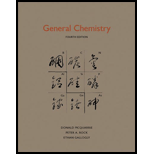
Concept explainers
(a)
Interpretation:
The equation has to be completed and balanced for the acid-base reaction of perchloric acid and calcium hydroxide. The products have to be named and the corresponding net ionic equation has to be written.
Concept Introduction:
Double replacement reactions: This type of reactions occurs when the cation and the anions switch between two reactants to form new products. In order for the reaction to occur, one of the products is usually a solid precipitate, a gas or a molecular compound.
Acid-Base reactions: A
(a)
Explanation of Solution
The product of the reaction between perchloric acid and calcium hydroxide is calcium perchlorate and water. The completed equation is,
The balanced equation is,
The corresponding ionic equation is,
Cancellation of the spectator ions
Dividing both the sides by two yields,
(b)
Interpretation:
The equation has to be completed and balanced for the acid-base reaction of hydrochloric acid and calcium carbonate. The products have to be named and the corresponding net ionic equation has to be written.
Concept Introduction:
Refer to part (a).
(b)
Explanation of Solution
The product of the reaction between hydrochloric acid and calcium carbonate is calcium chloride, carbonic acid. The completed equation is,
The balanced equation is,
The ionic equation is,
Cancellation of the spectator ions yields the net ionic equation. The net ionic equation is,
The decomposition of carbonic acid results in the production of water and carbon dioxide gas. The equation is,
The overall equation is,
The net ionic equation is,
(c)
The equation has to be completed and balanced for the acid-base reaction of nitric acid and aluminium oxide. The products have to be named and the corresponding net ionic equation has to be written.
Concept Introduction:
Refer to part (a).
(c)
Explanation of Solution
The product of the reaction between nitric acid iodide and aluminium oxide is aluminium nitrate and water. The completed equation is,
The balanced equation is,
Aluminium oxide is broken into aluminium (III) hydroxide and water.
The corresponding ionic equation is,
Cancellation of the spectator ions
(d)
The equation has to be completed and balanced for the acid-base reaction of sulphuric acid and copper hydroxide. The products have to be named and the corresponding net ionic equation has to be written.
Concept Introduction:
Refer to part (a).
(d)
Explanation of Solution
The product of the reaction between sulphuric acid and copper hydroxide is copper sulphate and water. The completed equation is,
The balanced equation is,
The corresponding ionic equation is,
Cancellation of the spectator ions
Dividing both the sides by two yields,
Want to see more full solutions like this?
Chapter 10 Solutions
General Chemistry
 ChemistryChemistryISBN:9781305957404Author:Steven S. Zumdahl, Susan A. Zumdahl, Donald J. DeCostePublisher:Cengage Learning
ChemistryChemistryISBN:9781305957404Author:Steven S. Zumdahl, Susan A. Zumdahl, Donald J. DeCostePublisher:Cengage Learning ChemistryChemistryISBN:9781259911156Author:Raymond Chang Dr., Jason Overby ProfessorPublisher:McGraw-Hill Education
ChemistryChemistryISBN:9781259911156Author:Raymond Chang Dr., Jason Overby ProfessorPublisher:McGraw-Hill Education Principles of Instrumental AnalysisChemistryISBN:9781305577213Author:Douglas A. Skoog, F. James Holler, Stanley R. CrouchPublisher:Cengage Learning
Principles of Instrumental AnalysisChemistryISBN:9781305577213Author:Douglas A. Skoog, F. James Holler, Stanley R. CrouchPublisher:Cengage Learning Organic ChemistryChemistryISBN:9780078021558Author:Janice Gorzynski Smith Dr.Publisher:McGraw-Hill Education
Organic ChemistryChemistryISBN:9780078021558Author:Janice Gorzynski Smith Dr.Publisher:McGraw-Hill Education Chemistry: Principles and ReactionsChemistryISBN:9781305079373Author:William L. Masterton, Cecile N. HurleyPublisher:Cengage Learning
Chemistry: Principles and ReactionsChemistryISBN:9781305079373Author:William L. Masterton, Cecile N. HurleyPublisher:Cengage Learning Elementary Principles of Chemical Processes, Bind...ChemistryISBN:9781118431221Author:Richard M. Felder, Ronald W. Rousseau, Lisa G. BullardPublisher:WILEY
Elementary Principles of Chemical Processes, Bind...ChemistryISBN:9781118431221Author:Richard M. Felder, Ronald W. Rousseau, Lisa G. BullardPublisher:WILEY





